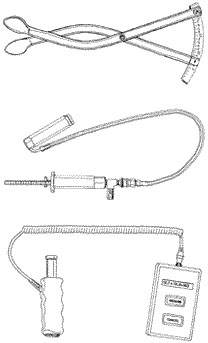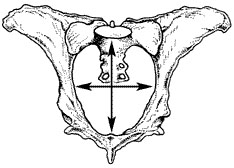Although researchers agree that birth weight is the most important measurable trait affecting calving difficulty, there is evidence that the size and shape of the pelvis also affect a heifer’s ability to calve.
Calving difficulty
Calving difficulty results in major economic loss to the beef cattle industry. Estimated losses resulting from dystocia (calving difficulty) equal or exceed $750,000,000 annually. Calving difficulty influences the economics of a cow/calf enterprise through increased calf death loss, increased labor and veterinary costs, reduced subsequent reproductive performance of the cow, potential loss of the cow, and reduced milk production.
Calf mortality may be four to eight times greater in dystocia cases than in normal births. The majority of calf deaths occur within the first 24 hours following calving (58 percent), with 75 percent of the total occurring within the first week of life. Studies indicate that calf death loss due to dystocia accounts for the single largest perinatal and postnatal death loss category through the first 96 hours after birth.
A number of factors affect calving difficulty, including:
- Birth weight of the calf
- Pelvic area of the cow
- Gestation length
- Sex of calf
- Inadequacies in heifer development
- Body condition of the cow at calving
- Abnormalities in hormone profiles at the time of birth
- Abnormal presentation of the calf at birth
We also know that the single major cause of dystocia is a disproportion between size of the calf at birth (birth weight) and the cow's birth canal (pelvic area). Differences in pelvic area are generally due to pelvic height, with discrepancies between the dam and fetus more likely to occur for pelvic height and depth of calf chest than for width measures.
Pelvic size, independent of cow weight, affects calving difficulty. Heifers of increased skeletal size usually have larger pelvic openings, but also tend to have heavier calves at birth. Hence, selection for cow size alone is ineffective.
Heifer weight and age generally have a positive relationship to pelvic area, but weight is not always a good indicator. External dimensions such as width of hooks and length of rump are not good indicators of pelvic area or calving difficulty. For these reasons pelvic measurements can be a useful management tool to eliminate heifers with a higher potential for calving difficulty.
Pelvic measurements
University of Nebraska researchers developed ratios that you may use to estimate deliverable calf size. You can divide total pelvic area prior to breeding by a ratio that is based on age and weight to estimate the amount of birth weight a heifer could accommodate as a 2-year-old without substantial difficulty.
Example: A 600-pound yearling heifer (Table 1) with a pelvic area of 140 square centimeters should be able to deliver, as a 2-year-old, a 67-pound calf without difficulty (140/2.1 = 67).
Table 1
Using pelvic measurements to estimate deliverable calf size (birth weight)
| Time of measurement | Heifer age | Heifer weight | Pelvic area | Pelvic area per birth weight ratio | Estimated calf birth weight |
|---|---|---|---|---|---|
| Before breeding | 12-13 months | 600 pounds | 140 cm2 | 2.1 | 67 pounds |
| 160 cm2 | 2.1 | 76 pounds | |||
| 180 cm2 | 2.1 | 86 pounds | |||
| Pregnancy exam | 18-19 months | 800 pounds | 180 cm2 | 2.7 | 67 pounds |
| 200 cm2 | 2.7 | 74 pounds | |||
| 220 cm2 | 2.7 | 82 pounds |
Pelvic measurements can be obtained at the time of pregnancy exam, but a factor of 2.7 should be used to estimate calf birth weight of 18- to 19-month-old 800-pound heifers. Tables 1 and 2 provide estimates of the deliverable calf size a heifer can accommodate at first calving based on pelvic area at given weights and ages. Scientists at the University of Nebraska suggest that these ratios appear to be good indicators of dystocia and report an accuracy of nearly 80 percent.
Table 2
Pelvic area per calf birth weight ratios for various heifer weights and ages to estimate deliverable calf birth weight
| Heifer weight | Age at time of measurement | |||
|---|---|---|---|---|
| 8 to 9 months | 12 to 13 months | 18 to 19 months | 22 to 23 months | |
| 500 pounds | 1.7 | 2.0 | ||
| 600 pounds | 1.8 | 2.1 | ||
| 700 pounds | 1.9 | 2.2 | 2.6 | |
| 800 pounds | 2.3 | 2.7 | 3.1 | |
| 900 pounds | 2.4 | 2.8 | 3.2 | |
| 1,000 pounds | 2.5 | 2.9 | 3.3 | |
| 1,100 pounds | 3.4 | |||
Structural traits in cattle tend to be highly heritable and pelvic area is no exception. This means there is a large genetic influence on pelvic area, which results in rapid response to selection. However, pelvic area is genetically correlated with many other traits, so selection for increased pelvic area alone can result in other traits changing for the worse. For example, selecting for increased pelvic area can result in increased birth weight and mature weight.
Pelvic measurements can be taken prior to the first breeding season and combined with a reproductive tract examination. Pelvic measurements should be used in addition to, not in place of, selection for size, weight, and above all, fertility. Producers should be aware that selection for pelvic area is likely to result in increased size of the entire skeleton and animal. Increased skeletal size of the dam will be reflected in higher birth weight and dimensions of the calf.
Pelvic measurements, on the other hand, can be used to successfully identify abnormally small or abnormally shaped pelvises. These situations, if left unidentified, are often associated with extreme dystocia, resulting in Cesarean delivery and even death of the calf or cow.
Pelvic measurements can be obtained with a Rice Pelvimeter (Figure 1A), manufactured by Lane Manufacturing, 2075 South Valencia, Unit C, Denver, CO 80231; the Krautmann-Litton Bovine Pelvic Meter (Figure 1B), manufactured Jorgensen Labs, Inc., 2198 West 15th St., Loveland, CO 80538; or the Equibov Bovine Pelvimeter (Figure 1C), manufactured by Equibov, 205 Harris Street, Rockwood, Ontario, CAN NOB2KO.
 Figure 1
Figure 1
Instruments to measure pelvic area in cattle
The vertical measurement is the vertical diameter between the symphysis pubis on the floor of the pelvis and the sacral vertebrae. The horizontal measurement is obtained by determining the horizontal diameter at its widest point between the left and right ileal shafts (Figure 2). These measurements are read in centimeters and multiplied together to obtain the total pelvic area in square centimeters.
 Figure 2
Figure 2
Obtain vertical and horizontal measurements to determine pelvic area
Measurements may be obtained by a veterinarian or an experienced producer. It is important that the person doing the measuring have a thorough understanding of the birth canal, pelvic structure, and reproductive tract. Practice and experience are necessary before accurate measurements can be obtained.
Summary
Calving ease will continue to be an important consideration as the industry produces fast-growing muscular progeny by terminal sires. These sires should be selected on measures of direct calving ease by using EPD (expected progeny difference) values for calving ease and birth weight.
To accommodate fairly heavy birth weights, scientists at Colorado State University recommend that you develop a cow herd that excels in maternal calving ease. Sires of replacement females should be selected to maintain cow size and milk production at levels compatible with available resources. In addition, cows should be selected for total maternal calving ease along with gestation length.
Research indicates that bigger is not necessarily better when one considers actual pelvic measurements. In other words, heifers with large pelvic measurements fail to calve more easily than average-sized heifers. However, heifers with abnormally small pelvises or abnormally shaped pelvises generally experience a higher than normal incidence of calving difficulty and should be identified and culled from the herd.
Remember, pelvic area and shape are only a part of the calving difficulty complex. Follow the suggestions in the following list to minimize the incidence and severity of calving difficulty in your herd.
How to reduce calving difficulty (in ranked order):
- Breed heifers to proven calving ease bulls (low birth-weight EPDs)
- Develop heifers to prebreeding target weights.
- Ensure that heifers are in good body condition going into the calving period (minimum body condition score of 5).
- Obtain pelvic measurements at yearling age and cull heifers with abnormally shaped or abnormally small pelvic areas.
This publication was adapted and revised from “Pelvic Measurements for Reducing Calving Difficulty,” by Gene H. Deutscher, NebGuide G88-895, of the Nebraska Cooperative Extension Service, University of Nebraska Institute of Agriculture and Natural Resources. The tables contain Nebraska data.